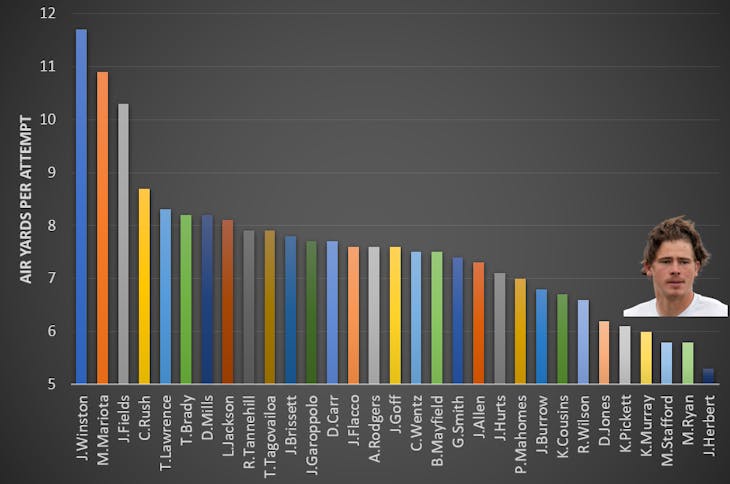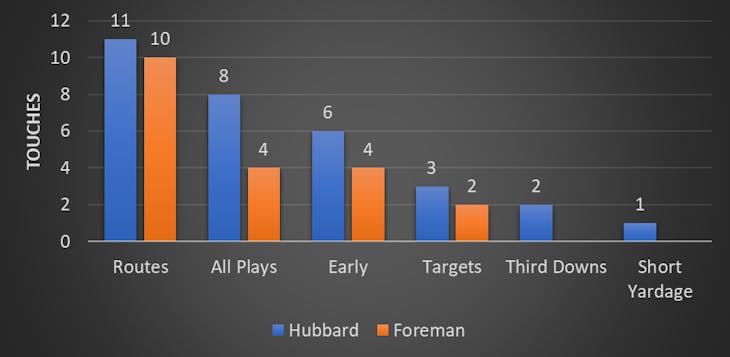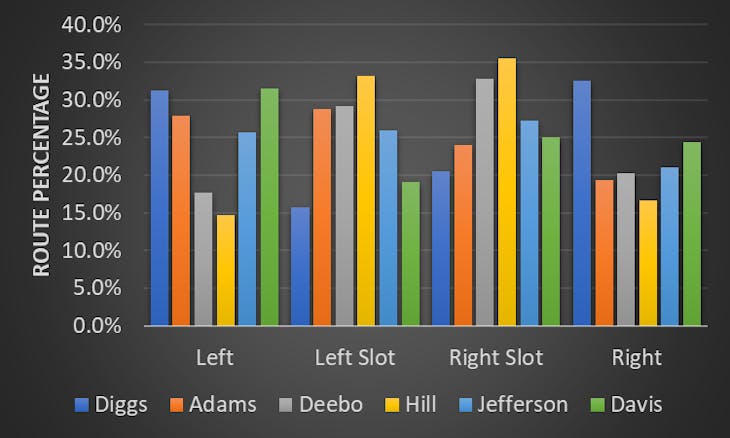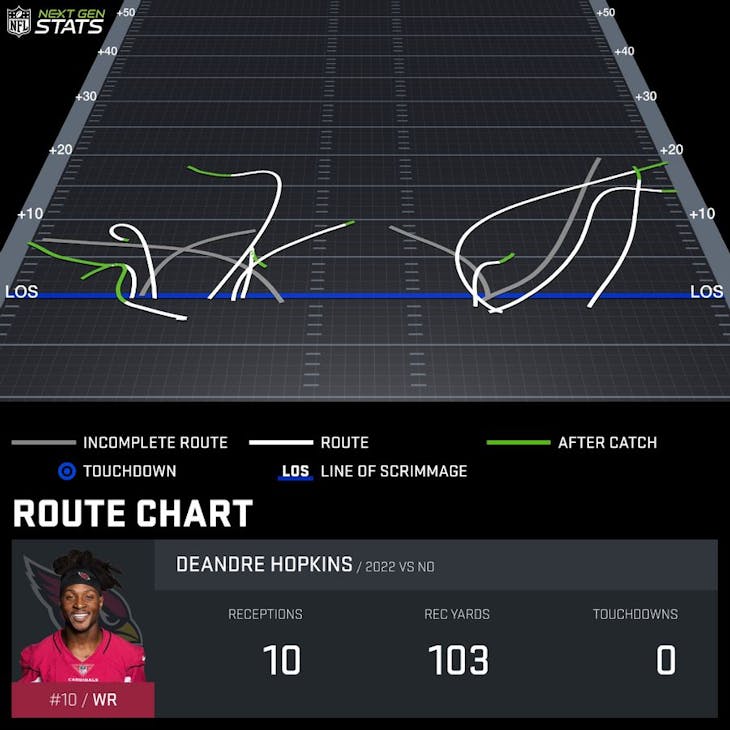My only hope for the week was for Thursday night to be entertaining. We’ve had epic Sunday night battles and enjoyable Monday night conclusions to the week. But we got one of the best memes of the season after Andy Dalton’s interception. So, I’m happy, but there were some disappointments on Sunday and Monday. Let’s walk through three of my lessons learned from the weekend as we head into Week 8.
Quarterback: Justin Herbert, Chargers
Week 7 Results: (Projected) 19.0, (Actual) 18.1
I was somewhat surprised to see a Sunday shootout between the Seahawks and Chargers. But the score shocked me more. Seattle opened the season with one of the worst defenses in the league. I expected Justin Herbert to be the QB1 for the weekend. Mike Williams got hurt, and Keenan Allen only played 32% of the snaps. It explains some of the disappointment, but something else was wrong with the Chargers’ offense in Week 7.
Advice Moving Forward
Herbert is a fringe QB1 moving forward. Los Angeles’s passing volume will buoy his results, but the offense is inefficient outside of explosive plays.
If you never watched a Chargers game, you might be happy with Herbert’s results. His 17.3 PPG is fine, given Keenan Allen hasn’t played since Week 1. Plus, with Austin Ekeler averaging 8.7 targets per game, you’d think the offense has found a way to adapt to the loss. But really, it’s a band-aid on a gunshot wound.

Herbert’s 5.3 air yards per attempt on first down rank dead last amongst all starters. The guy with a cannon attached to his right shoulder can’t throw it farther than Matt Ryan in early-down situations. But I’m not solely blaming him. Look at his personnel.
Mike Williams is a contest-catch receiver. Joshua Palmer and DeAndre Carter can’t beat press coverage. Herbert’s options are limited, so this is the result. And it impacts the Chargers’ later decisions, too.
It may seem weird to harp on a small aspect of their offense, like how far someone throws on one down. But information from one play informs the next. Also, shorter down and distances are easier to convert. However, if you’re not picking up more yards on first down, you find yourself where the Chargers are now.
| Scenario | Rank |
|---|---|
| 3rd Down with 3+ YTG | 12th |
| 3rd Down with 5+ YTG | 6th |
| 3rd Down with 7+ YTG | 7th |
Los Angeles is living in third and long situations. Herbert is top 12 in plays run from nearly every distance to the sticks. He’s picking them up at the 14th-highest rate, but it’s a hard way to live for an entire season. And he’s lost yet another receiver for an extended time.
Herbert’s rib injury from Week 2 has removed any rushing upside he had from years past. Derek Carr has more designed attempts at this point. The Chargers are fifth in PROE, so his volume will likely keep him afloat while his pass-catchers get healthy. However, without an established primary receiver, his floor is all we can count on for now.
Running Back: Chuba Hubbard, Panthers
Week 7 Results: (Projected) 5.1, (Actual) 15.3
Nobody expected Carolina to trade away one of their best offensive players. However, we did have expectations as to who would fill in a McCaffrey-sized void should he miss time. D’Onta Foreman was a popular backup to target in drafts, given McCaffrey’s injury history. After the trade news dropped, Foreman was on every roster. But the Panthers threw us a curveball on Sunday, and we saw a bit more of Chuba Hubbard than anyone anticipated.
Advice Moving Forward
Hold or trade Hubbard. His workload is worthy of a bye-week fill-in with positive upcoming matchups over the next four weeks.
We decided back in August who to target in Christian McCaffrey’s absence. D’Onta Foreman had multiple 100-yard games while still in Tennessee, and Carolina gave him a $2M contract. Meanwhile, Chuba Hubbard only averaged 3.7 yards per carry over ten starts. Clearly, Foreman was the superior talent to roster, and Hubbard would be an afterthought.
To be clear, I used YPC to denote sarcasm. Regardless, things change. And, more often than not, our preseason predictions about backup running back situations are wrong. So, when teams present us with new information, we must react accordingly versus clinging to our priors. Hubbard’s Week 7 workload should make us rethink the off-season narrative.

Hubbard’s injury isn’t a long-term concern, but it kept him from finishing the game. However, when both running backs were available, Hubbard was the guy. He doubled Foreman’s carries, saw (one) more targets, and earned the short-yardage/third-down role. In essence, he was an RB2. But, how each fared with their touches injects some uncertainty for future opportunities.
| Metric | Hubbard | Foreman |
|---|---|---|
| Success Rate | 50% | 50% |
| Missed Tackles | 4 | 2 |
| Yards After Contact per Attempt | 4.1 | 4.7 |
| Explosive Runs | 3 | 4 |
| Yards per Route Run | 0.9 | 2.7 |
Foreman stans should be excited. Their preferred option outproduced Hubbard on the ground and was more efficient through the air. But both showed they’re capable of playing the position. As such, Hubbard deserves a roster spot. And their schedule is beneficial to the pair.
Carolina faces Atlanta twice, Cincinnati, and Baltimore. All four are bottom-10 in rushing EPA allowed. The Falcons and Ravens have given up at least one score on the ground in five of their seven games. At worst, Hubbard is a bye-week/injury fill-in worth a spot start. At best, you can package him in a trade for an upgrade at another position.
Wide Receiver: DeAndre Hopkins, Cardinals
Week 7 Results: (Projected) 16.4, (Actual) 20.3
Hopkins is back! The star wide receiver returned Thursday night to deliver a top-12 finish for the managers who held on to him for six weeks. But I saw “sell high” recommendations before his debut, which gave me pause.
Now, I get it. Some folks may be in dire straits after other injuries and bye weeks. Hopkins’s name value was worth tossing out on the trade block. However, after Thursday, I took a closer look at his opportunity and would consider him more valuable than ever.
Advice Moving Forward:
If you’re a competing team, hold Hopkins. Trade away Hopkins if you’ve fallen behind in your league due to injuries. However, his value aligns with a top-12 wide receiver’s, given his usage on Thursday night.
My concerns about Hopkins didn’t rest on Hopkins, the player. I mean, sure. He’s 30 years old, has been injured a few times, and his 17.7% target share from last year wasn’t very “Hopkinsian,” to coin a term. I figured he would return at full strength after an offseason to reconnect with Murray and the additional suspension time. I was more worried about how Kingsbury would use Hopkins.

Good passing offenses are creative. They move their best player around despite coverage rolling their way every snap. Last year, the top wide receivers spent equal amounts of time on the left and right sides of the field. For example, Stefon Diggs was at 31.2% and 32.6%. His slot snaps were also nearly identical (15.7% and 20.5%). It seems simplistic, but giving a defense a variety of looks keeps them guessing. Arizona went a different (read: worse) route.
| Metric | Rate |
|---|---|
| Left Perimeter Routes | 65.1% |
| Slot Routes | 16.6% |
| Screens | 2.4% |
Look, I don’t work for the Cardinals or know Hopkins personally. Maybe Hopkins likes the left side. But he ran the ninth-most routes from the left perimeter in 2021. He only played ten games. A.J. Green had more targets from the slot. Antoine Wesley had the same number of opportunities on screens. Instead of being *the* guy, Hopkins was just *a* guy in Arizona’s offense. But he re-established himself on Thursday night.

Hopkins was everywhere during TNF. It’s a one-game sample, but his 9.2 aDOT is nearly four yards shallower than last year (13.1). He led the team in slot targets and had a 60.6% air yard share. He looked like the Hopkins of old.
The fear was Hopkins’s deployment would look as siloed as it had in years past, stagnating his production. However, his Thursday night usage, coupled with positive matchups over the next two weeks (at MIN, vs. SEA), should boost our confidence. We should value him like a top-12 option should he be part of any trade negotiations. Otherwise, managers should start him without any doubts moving forward.
